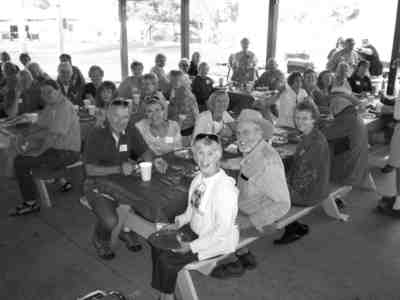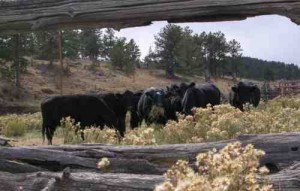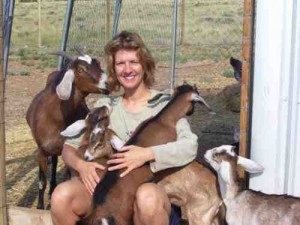Article by Jennifer Dempsey
Hospice – January 2008 – Colorado Central Magazine
MORE THAN 50 PEOPLE throughout Chaffee County volunteer for Angel of Shavano Hospice. Working in conjunction with hospice doctors, nurses, social workers and therapists, these trained men and women visit dying patients to talk or not talk, to stroke a forehead or massage hands, to run errands, to clean house, and almost always to provide the caregiver with a much-needed break.
Yet hospice volunteers insist they receive much more than they could ever give through their work.
“I gain a lot more than my clients do and that’s not an exaggeration,” said Tony Watkins, a volunteer for five years. “The whole situation requires honesty, even if it’s painful, and there’s something to be said for that. Often time people keep a veil or cloudiness around death, but it’s a thing that happens. I really feel that volunteering for hospice is one of the most fulfilling things I have done. It’s better than church, that’s just my opinion.”
“It’s much better than church,” said Karen Bowers, a volunteer from Buena Vista since 1989. “People always say, ‘How can you do it?’ But I get so much out of it, something I never got from anybody else in my whole life, my family or my friends. I think you have to go through it to realize. Yeah, you give a lot, but I feel I get more out of it. When it gets to the stage where they are about to go, if the bed is big enough, you crawl in bed and hug them. Most people go with peace. It comforts them to have body contact, especially if they don’t have relatives around. It is a privilege, there’s no doubt about it.”

“A funny thing happens on the second or third meeting between a male volunteer and male patient,” said Frank “Kiko” Maestas, a former paramedic who has been a volunteer for four years. “We form a bond and sometimes when I go visit we don’t even speak, we just look into each other’s eyes. We know what’s happening. They say when someone is very close to the end they enter a blessed or holy place. Our bonding is part of that. It happens with the female volunteers too, they form a sort of sisterhood bonding. These people who are terminally ill are walking on their last path of life and they have sometimes very little to look forward to, so I like to go and give them a smile or a touch of a hand. These people have already served mankind so I want to serve them.”
Betsy Miller, who started volunteering last fall, said, “Some people say ‘Oh dear I could never do that.’ I can understand that because it’s sad sometimes. It sounds bizarre but working in hospice is kind of rejuvenating because of the power of the connection (between you and the client). It’s such an incredibly intimate exchange. You hardly ever find that, not even in the closest family. We all have so many defenses. With hospice it just opens right up. A son of one of my clients, if you saw him in Safeway he’d say hi and walk on by, but here he can say, ‘I just feel so helpless.’ People don’t normally talk like that. It’s a wonderful privilege really, to be able to communicate on that level, to have the opportunity to relate in that way.”
VOLUNTEERING “has taught me to step back and not think that I can control anyone or change any of the situation for the client,” said volunteer Irene Mable, “but just to be there and to help as much as I can. As a volunteer you’re a great asset to family at a time when they really need the support. One particular client I have has accepted the fact that she’s dying. She lives day to day and enjoys life as much as she can. She’s just a joy to be around. It’s too bad more families don’t take advantage of it. They may think ‘Oh no! that means death,’ but it means a more peaceful time for them prior to the time.”
Karen Latvala from Coaldale became a hospice volunteer after her own near-death experience.
“I got the hantavirus and had a close brush with death,” she said. “I was telling one volunteer how I thought it was a spiritual experience for me and he strongly suggested I get involved with hospice. My first experience was with an 88-year-old woman. The first few times she didn’t seem sick at all. When she became bedridden she went downhill pretty quickly and it was just a matter of being with her. Her son asked me, ‘What do you do when you sit there for so long?’ I told him I was just sending her love. I was happy to sit and listen, to just hold the space for whatever it is that’s needed.”
BARB SIMONSON, a former midwife, began volunteering last year. “It’s so special and a real honor to be there in any capacity. It’s a very intimate glimpse into people’s lives at a very intense time of change for them. Just to be able to contribute a little bit, to give the caretakers a little time, is very rewarding. I had a client who was really at the end stages when hospice entered in and her husband just needed to have time to go to the funeral home and the bank. It’s really their call. Some people are very private and really don’t want (too much interaction) and you have to respect that.”
Salida author Laura Hendrie wrote about her experience with hospice.
“Hospice workers have stumbled on a marvelous secret: when one person is dying, and another is willing to care for them, a transaction takes place. It may look like a one-way deal, with the healthy caregiver over here, giving comfort to the sick person over there. But it is never that simple. Hospice, at its best, works both ways. The more we give to patients, the more we realize how much they’ve given us. The more we learn how to comfort someone who is dying, the deeper they seem to know exactly how to comfort us. Families may thank us for what we’ve done, but if we do our job well, when we leave, we’re the ones who always feel we’ve gotten the greater gift. Why? Because we get to see what real courage looks like. What honor and dignity mean. Our patients teach us how to listen instead of know, how to learn instead of teach, how to give love without being anyone special, and most important, how to accept love without being afraid of loss. Hospice work, at its best, has very little to do with death. It’s about life.”
Anyone who has been diagnosed with a life-limiting illness and has a life expectancy of 6 months or less qualifies for hospice care. Medicare and most health insurance policies provide coverage for hospice care. However, no one is denied hospice services based on financial circumstances
For more information about hospice services or how to become a hospice volunteer, call volunteer coöordinator Cathy Haruf at 719-539-7638.
Jennifer Dempsey is a free-lance writer and director of the Salida Circus.



